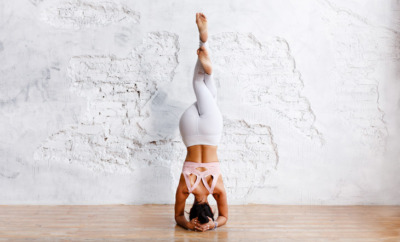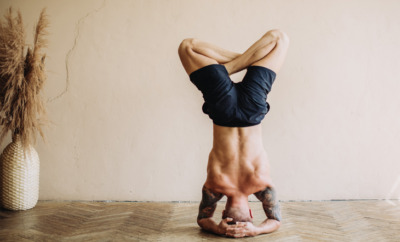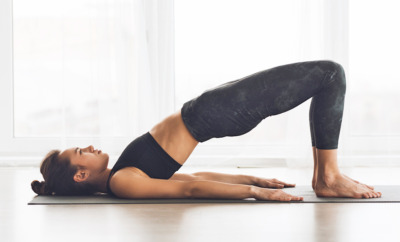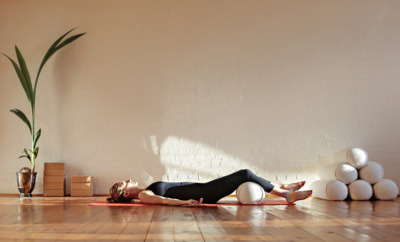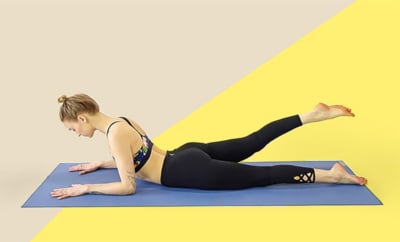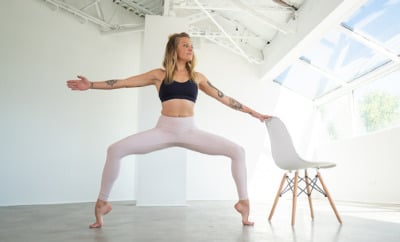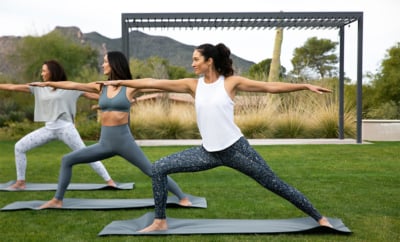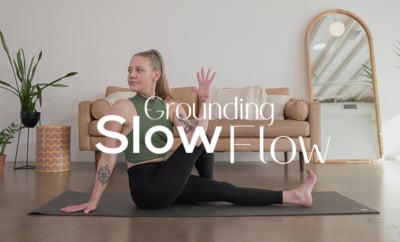Flip Your Perspective with Headstands: Here’s Your Complete Headstand Pose Guide & Tips to Do Them Safely

headstand saftey
Headstand Pose, also known as Shirshasana, is the yoga pose where you literally stand on the top of your head. If you are curious about how to do a Headstand Pose – safely and correctly – then look no further. This is your complete guide to flipping your world upside down and balancing on your head.
Due to its many benefits, including immensely improving your physical and mental health and well-being, Shirshasana is one of the main poses in Hatha Yoga and is also referred to as “The King of Asanas.”
When balancing in Headstand Pose, not only is the body upside down – the blood pressure is also reversed. The blood pressure changes in the head, neck, shoulders, veins, blood vessels, lungs and legs. This movement forces the body to react to keep the balance in different body systems.
The thought of increasing blood in the head might sound a bit scary. Fortunately, our body has strong systems to keep the body and the brain safe.
Read on for an overview of Headstand Pose, including the benefits, when to avoid this inversion pose, proper alignment and steps on how to do a Headstand Pose. We also included a few other important tips for practicing Shirshasana, including modifications, common mistakes, and our take on why you shouldn’t practice against a wall.
Want to Balance On Your Hands Instead?
If you love Headstand Pose or want an alternative to balancing on your head, try Handstand Fundamentals! This 30-minute YA Classes workshop-style class builds on some of the principles you learned in your Headstand Pose practice.
Benefits of Headstand Pose
Headstand Pose has a lot of benefits and is safe to practice when you are in good physical health and practice the pose under guidance of an experienced teacher.
- Stimulates the pineal gland, hypothalamus and pituitary gland. This causes the other endocrine glands to coordinate and function better
- Improves the condition of the brain, eyes and ears by the increased blood pressure
- Improves concentration and memory
- Alleviates mental fatigue, depression and anxiety
- Improves the function of the central nervous system
- Improves the ability of the body to regulate the blood pressure by stimulating the baroreceptors
- Improves the condition of the heart by the reversed blood pressure
- Improves posture and activates/strengthens the core
- Strengthens the muscles in the back, shoulders and arms
- Improves the blood regulation and the circulation of lymph in the entire body
- Improves the digestion and stimulation of the removal of harmful substances
Don’t Do Headstand Pose If . . .
Due to the complex nature of the pose, Shirshasana is not for everyone. The following people should not practice Headstand Pose:
- Children under the age of 7 years old, as their skull can still be soft and is prone to injuries
- Pregnant women, because there is a high risk of falling out of the pose
- People with Glaucoma, because it can increase the pressure in the eyes
- People who suffer from acute or heavy migraines
- People with shoulder or neck issues need to be fully recovered before attempting Headstand Pose
- People with hypertension, because it can aggravate the disorder
- People with serious heart problems
- People with osteoporosis
Looking for more articles on Yoga, check out our full library of Yoga articles here
Understanding Proper Alignment and Safety in Shirshasana
Proper alignment while practicing Headstand Pose is very important. When your alignment is not optimal, it can cause injuries instead of benefits.

In figure A, the weight of the body is divided in a 80/20 ratio between the head and the arms. The core of the upper body and the back are equally active. This is the ideal alignment for those who want to stay in Headstand Pose for a longer period of time.
In figure B, the weight of the body is divided in a 20/80 ratio between the head and the arms. There is more weight on the arms and less on the head. The core of the upper body is more active than the back muscles. This alignment is perfect for those who want to build up core control and who want to have less pressure on the neck.
For beginners, this is the safest way to start practicing Headstand Pose. If you feel comfortable in this alignment for 30 seconds, you are ready to adjust the pose to the alignment shown in figure A.
In figure C, the weight is on the neck and hands. The back muscles need to work hard to stay in this pose, because of the way the hips are hanging towards the front. The core is not adequately engaged. This alignment is not ideal, because it causes a lot of pressure to the neck and the back which can lead to injuries.
In figure D, the weight of the body falls beyond the head which makes it almost impossible for anyone to stay in this pose.
Figures A and B are appropriate for practicing Headstand Pose, while figures C and D should be avoided.
Here Are 10 Reasons to Do Inversions (In Case You Needed an Excuse)
Here’s How to Do a Headstand Pose
An empty stomach is ideal, so try not to eat for 2-3 hours before practicing Shirshasana. Make sure you spend time warming up before entering into the pose. You may want to start in Child’s Pose for several breaths before moving into the next steps. This pose neutralizes the blood pressure in the legs and in the head.
If you are not practicing on a soft, natural surface, use a 3-5 centimeter thick blanket underneath the head to protect the skull.
To practice Headstand Pose, follow these steps:
- Sit on the knees and grab opposite elbows to measure the ideal distance between them. Once you have the right distance between the elbows, bring your arms to the floor, directly beneath your shoulders
- Bring your hands together and interlace your fingers, making a basket. Make sure to keep the elbows in the same place during the entire pose and not move them in- or outside. The arms should make a triangle shape
- Place the head on the floor and the back of the head in your cupped hands
- Curl the toes, straighten the knees and push the hips towards the ceiling
- Walk your feet towards the shoulders
- Bring your right knee into the chest and then follow by also bringing the left knee to the chest, so the spine is straight
- Take a deep breath and bring your legs up, reaching towards the ceiling. Look at a focus point that is eye level. Keep breathing and hold the pose for as long as feels comfortable
- To come out, maintain a strong core and shoulder engagement, and slowly and mindfully lower one leg down to the ground, followed by the other. You can also try to bring your knee into your chest first. Sit back on your knees and pause and breathe into your shoulders and neck
Other Important Tips for Practicing Headstand Pose
1. Modifications
- Push your shoulders away from the ears to protect the neck from excess pressure
- Do not let the hips go beyond the shoulders, so you don’t lose balance and fall out of the pose
- When practicing near a wall, do not lean against it. Try to only use it as a safety net to keep you from falling
2. How Long Should I Hold the Pose?
There are many different opinions of the maximum amount of time to stay in Headstand Pose. The oldest Hatha yoga scriptures tell us you can stay in Headstand Pose for as long as you can, as long as it is comfortable and stable and you do not have to exert extreme effort to remain in the pose. Over time, you start to notice that little by little you can stay in the pose for a longer period of time.
3. Frequent Mistakes of Shirshasana
A lot of people are not capable of practicing Headstand Pose the correct way. They feel pain or get injured because of the following frequently made mistakes:
- The hips go beyond the shoulders
- Placing your elbows too far away from each other
- Placing the head in a wrong position – either too far towards the forehead or too far towards the back of the head
- Practicing the pose on too hard of a surface
- Breathing too quickly or too shallow
4. Why Practicing Headstand Pose Against a Wall Is Not Recommended
You should avoid using a wall when practicing Headstand Pose because you are not using the right muscles to divide the weight during the pose. Instead of bringing the weight on the head and arms, you tend to bring the weight to the wall, which makes you stay in the pose for longer than your body can actually manage, which can potentially lead to injuries.
5. Common Myths
Throughout the years, many misleading myths have formed about Shirshasana. Examples are:
- During pregnancy you can hurt the baby (we recommend not practicing Headstand Pose while pregnant, but only because of the risk of falling)
- Headstand can damage the brain
- Headstand is not safe for the neck (only true with neck injuries)
- Headstand is not safe for the eyes (only true with Glaucoma)
When practiced properly, this inversion can be energizing and restorative. We encourage you to practice mindfully, learn from a skilled and experienced teacher, and listen to your body! You know what’s best.
Flip Your Perspective – Practice Shirshasana Today!
Headstand Pose provides many benefits when performed the right way. We recommend you learn Shirshasana from a skilled and experienced teacher who understands the pose very well, and once you’ve learned this valuable pose, you will reap the many benefits of inversions and all the wonderful ways they positively impact your mind and body.
Enjoy practicing “The King of Asanas” and be sure to ask us any questions or share your inversion stories in the comments below. Happy Headstands!


This Month's Letter
From the Editor
Monthly motivation and food for
thought from our founder.



